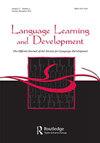Morphosyntactic Cues for Quantifier Comprehension in Children
IF 1.4
2区 文学
0 LANGUAGE & LINGUISTICS
引用次数: 0
Abstract
ABSTRACT Universal quantifiers, which refer to groups of individuals or events, can express a subtle distinction between collective (unified or simultaneous) and distributive (individuated and separate) events. Indeed, English uses different quantifiers for this distinction (“all” and “each”, respectively). Hebrew, however, has a single universal quantifier. Thus, the collective/distributive distinction associated with the universal quantifier is represented morphosyntactically. This study examined whether Hebrew-speaking children (4–6 year olds) detect the collective/distributive distinction based on morphosyntactic cues alone and whether they show similar performance pattern as adults. Using a novel drawing task, instructions were given in either a collective-preferred form or a distributive form, asking participants to add drawings to pictures of multiple items. Within-subjects (Experiment 1) and between-subjects designs (Experiment 2) were used. Overall, children distinguished between the forms, indicating that they attended the specific morphosyntic cues of these two forms. They produced distributive drawings following the distributive form, similarly to adults. However, they alternated between distributive and collective drawings following the collective-preferred form, unlike adults who mostly gave collective responses. We discuss a possibility for the interplay between the meaning of the universal quantifier and the morphosyntactic cues in children’s performance. This study provides insights into the acquisition of meaning that depends on morphosyntax.儿童量词理解的形态句法线索
通用量词是指一组个体或事件,可以表达集体(统一或同时)和分配(个性化和分离)事件之间的微妙区别。事实上,英语使用不同的量词来区分(分别是“all”和“each”)。然而,希伯来语只有一个全称量词。因此,与全称量词相关的集体/分配区别在形态句法上表现出来。本研究考察了讲希伯来语的儿童(4-6岁)是否仅根据形态句法线索就能发现集体/分配的区别,以及他们是否表现出与成人相似的表现模式。使用一种新颖的绘画任务,以集体偏好的形式或分配形式给出指示,要求参与者在多个项目的图片上添加绘图。采用受试者内(实验1)和受试者间(实验2)设计。总的来说,孩子们区分了这两种形式,表明他们参与了这两种形式的特定形态合成线索。他们按照分配形式绘制分配图,与成人相似。然而,他们在分配和集体绘图之间交替,遵循集体偏好的形式,不像成年人大多给出集体反应。我们讨论了普遍量词的意义和形态句法线索在儿童表现中的相互作用的可能性。这项研究提供了对依赖于形态句法的意义习得的见解。
本文章由计算机程序翻译,如有差异,请以英文原文为准。
求助全文
约1分钟内获得全文
求助全文

 求助内容:
求助内容: 应助结果提醒方式:
应助结果提醒方式:


